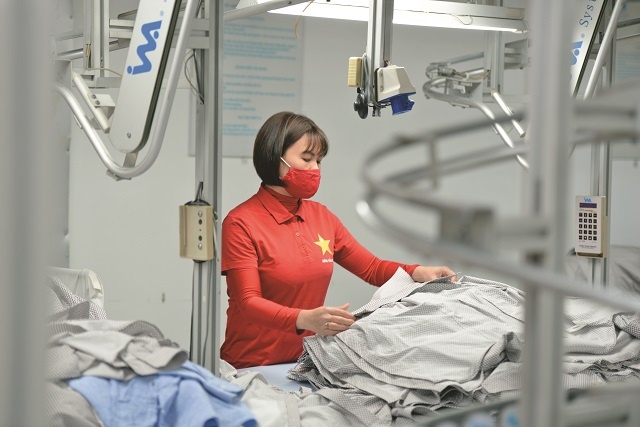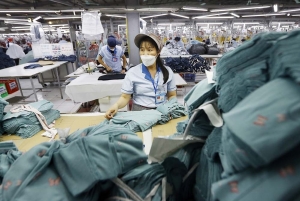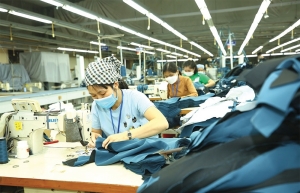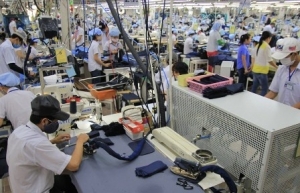50 per cent of textile firms adopt sustainable production
 |
Trung Quy Textile in the Mekong Delta province of Long An spent more than $11.4 million on environmentally friendly production processes, allowing the company to save 60–70 per cent on water compared to the previous weaving and dying technology.
"The business exports two containers of fabric made from organic fibres to a US partner. This is the initial cargo since we took pleasure in the possibility to invest in a new factory equipped with German and Italian technology five years ago and to transition to a sustainable manufacturing model at the end of 2022. All apparatus and equipment at Trung Quy have the green label as a result," said Tran Van Quy, general manager of the company.
In addition, businesses like Tran Hiep Thanh Textile Corporation use coal instead of tree bark to supplant emission sources like furnaces, gas, and green energy control.
"Thanks to the cost monitoring structure, we've been able to use 80 per cent green fuel and 30 to 35 per cent recyclable materials," said Le Van Linh, director of the Equipment Infrastructure at Tran Hiep Thanh.
This is one of the prevalent instances of greening textile industry production. Vu Duc Giang, chairman of the Vietnam Textile and Apparel Association (VITAS) said, "Approximately 50 per cent of textile and garment firms have greened manufacturing so that they can receive orders in today's challenging and fiercely competitive market."
He said that sustainable development is the path forward for the textile industry. However, this path is extremely perilous, and the greatest obstacle is a lack of financial resources. Therefore, environmentally conscious production requires specific policies and procedures.
"It is conceivable to establish a resource and environment fund from which enterprises can borrow at zero or between 1 and 2 per cent per year to invest in sustainability," Giang said, adding that the policy should be implemented as soon as feasible because global competing regulations would not wait for anyone.
In addition, it is essential to be mindful of the objective of sustainable growth, to invest in manufacturing facilities, technology, renewable energy, and the environment, and to educate the leadership team and staff.
According to VITAS, Vietnam's garment and textile industry's export turnover fell by 17.6 per cent in H1/2023, to $18.6 billion.
 | Textile apparel sector in dire straits Businesses in the textile apparel sector face critical times amid sinking domestic and global demand, and a heavy drop in export processing fees. |
 | Apparel groups anticipate ongoing rocky progress India and Bangladesh are competing with Vietnam for garment orders, but China is the most formidable rival, while Cambodia and Myanmar are emerging as new exporting nations. |
 | Textile apparel sector losing advantage in price competition Many producers in the textile apparel sector are on tenterhooks as export orders are increasingly shifting to other countries like Bangladesh or India for more favourable pricing. |
What the stars mean:
★ Poor ★ ★ Promising ★★★ Good ★★★★ Very good ★★★★★ Exceptional
Related Contents
Latest News
More News
- TCP Group partner with VNUS to launch water conservation project (December 25, 2025 | 14:00)
- Heavy industries set for pilot greenhouse gas quotas (December 25, 2025 | 10:00)
- Swedfund invests in MSME growth and climate action in Vietnam (December 19, 2025 | 11:42)
- GreenYellow brings solar energy to light up remote schools in Tuyen Quang province (December 19, 2025 | 08:00)
- Charge+, Grab partner to develop EV charging network in Vietnam (December 18, 2025 | 17:11)
- Linking sci-tech and innovation to Vietnam’s net-zero future (December 18, 2025 | 14:31)
- Driving double-digit growth through green and circular transformation in Vietnam (December 17, 2025 | 09:00)
- Standard Chartered and ACCA deepen collaboration to develop Vietnam’s talent for a sustainable future (December 15, 2025 | 18:18)
- Schaeffler reports strong early output from Dong Nai solar project (December 12, 2025 | 15:16)
- Forestry conference highlights biodiversity and sustainability goals (December 09, 2025 | 13:35)

 Tag:
Tag:





















 Mobile Version
Mobile Version